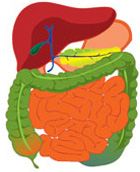 As UHN's monthly research newsletter, NRx reports on the full spectrum of leading research from UHN's five research institutes. Located in downtown Toronto, these institutes are the Princess Margaret (PM) Cancer Centre, the Toronto General Research Institute (TGRI), the Toronto Western Research Institute (TWRI), the Toronto Rehabilitation Institute (TRI) and the Techna Institute (Techna).
As UHN's monthly research newsletter, NRx reports on the full spectrum of leading research from UHN's five research institutes. Located in downtown Toronto, these institutes are the Princess Margaret (PM) Cancer Centre, the Toronto General Research Institute (TGRI), the Toronto Western Research Institute (TWRI), the Toronto Rehabilitation Institute (TRI) and the Techna Institute (Techna).
In this issue you can read about:
- A "weekend passport" that helps stroke survivors return home
- How normal tissue surrounding cancer impacts disease
- A biomarker for lupus that can measure disease severity
- Image-guided biopsies that better identify prostate cancer tissue
- Controlling blood fat levels using a gut hormone
- Funding for cancer research and clinical testing of a stroke drug
We hope that you will find NRx informative. If you have feedback or questions, please contact www@uhnresearch.ca.
Christopher J. Paige, PhD, FCAHS
Vice President, Research
University Health Network

The Public Health Agency of Canada estimates that 315,000 Canadians were living with the effects of stroke in 2011.
Stroke can lead to physical and functional deficits including paralysis, physical pain, emotional disturbances and difficulty swallowing, speaking or thinking. Although a number of specially designed rehabilitation programs exist that help stroke survivors recover as much of their strength and function as possible, patients and their caregivers often comment that the transition home can be the most difficult.
A team of researchers led by TRI Adjunct Scientist Dr. Jill Cameron demonstrated that allowing stroke survivors to go home for the weekend (on a "weekend pass") can inform their rehabilitation program and facilitate the transition home.
To gain insight into the impact of the weekend pass, the researchers interviewed patients, caregivers and their health care providers after the first weekend pass and four weeks after returning home. Researchers found that the weekend pass helped stroke survivors identify challenges at home that could be addressed in their rehabilitation programs prior to discharge from the hospital. It also helped caregivers understand the stroke survivors' abilities and better prepare for bringing their family member home. Moreover, the study revealed ways in which the current weekend pass could be modified to better meet the needs of patients and their caregivers.
Dr. Cameron comments, "Enhancing the process for the weekend pass is one way to help patients and families manage one of the most challenging of transitions within the health care system—the transition home."
This work was supported by the Ontario Stroke Network.
Stroke survivors', caregivers', and health care professionals' perspectives on the weekend pass to facilitate transition home. Cameron JI, Bastawrous M, Marsella A, Forde S, Smale L, Friedland J, Richardson D, Naglie G. J Rehabil Med. 2014 Aug 28. [Pubmed abstract]

Tumour growth is often likened to a "seed" (cancer cells) growing in "soil" (normal tissue environment). Loss of TIMPs in the soil promotes growth of the seed.
Tumour growth and metastasis are dependent not only on the properties of the tumour itself, but also on the features of the surrounding normal tissue. Cells in the normal tissue environment, or stroma, are often altered to support the growth and eventual spreading of cancer cells to other organs. How the stroma interacts with the tumour is complex and all the signals between them are not fully known.
A new article by PM Cancer Centre Senior Scientist Dr. Rama Khokha identifies the TIMP family of proteins in the stroma as important for restricting tumour growth. Using experimental models and human tumour samples, Dr. Khokha found that loss of TIMPs changed normal cells in the stroma into cancer-associated fibroblast (CAF) cells. CAFs released "exosomes"—encapsulated cellular components—that interacted with tumour cells and helped them grow. Loss of TIMPs also enhanced the activity of enzymes within these exosomes to promote cancer growth and metastasis. Dr. Khokha explains, "We found that the Timp gene family governs the emergence of a CAF-like cell state, impacting tumour progression through a mode of stroma-tumour communication that activates key cancer-supporting pathways."
This study has revealed clues to the consequences of TIMP loss in cancer, and suggests that restoration of TIMP function in the tissue surrounding cancer may restrict tumour growth and metastasis.
This work was supported by the Canadian Institutes of Health Research, the Ontario Institute of Cancer Research and The Princess Margaret Cancer Foundation. T Kislinger is a Tier 2 Canada Research Chair in Proteomics in Cancer Research.
Loss of the Timp gene family is sufficient for the acquisition of the CAF-like cell state. Shimoda M, Principe S, Jackson HW, Luga V, Fang H, Molyneux SD, Shao YW, Aiken A, Waterhouse PD, Karamboulas C, Hess FM, Ohtsuka T, Okada Y, Ailles L, Ludwig A, Wrana JL, Kislinger T, Khokha R . Nature Cell Biology. 2014 Sept. [Pubmed abstract]

The highly varied symptoms of lupus (also known as systemic lupus erythematosus) include joint pain, fever, light sensitivity, fatigue, hair loss and skin conditions.
Lupus is a condition in which the body's immune system attacks multiple organs. The disease is often hard to diagnose because the exact symptoms differ in each person and vary over time. Often patients with lupus experience "flares" when their symptoms worsen. Currently, blood tests for two proteins (anti-dsDNA and C3) are used to diagnose lupus; however, they do not always provide reliable readouts of disease activity. As a result, lupus is often underdiagnosed or overdiagnosed, which can lead to serious medical complications.
Researchers are searching for other molecules (eg, biomarkers) that better predict disease state. At TWRI, Principal Investigator Dr. Carolina Landolt-Marticorena and Senior Scientist Dr. Joan Wither have helped advance this global search. Their study, published in Rheumatology, found that immune molecules in the blood, known as anti-nucleosome antibodies, out-performed traditional biomarkers. Specifically, levels of anti-nucleosome antibodies were better able to predict the severity of lupus symptoms over time in individual patients.
Dr. Landolt-Marticorena comments, "While anti-nucleosome antibodies performed as well as widely used biomarkers, their real advantage is that levels of this biomarker actually mirror changes in disease activity over time. Thus, anti-nucleosome may serve as a valuable personalized readout of disease, leading to better informed and more effective treatment decisions."
This study was supported by the Canadian Institutes of Health Research and the Alliance for Lupus Research. PR Fortin is a Tier I Canada Research Chair in Multidisciplinary Health Research.
Anti-nucleosome antibodies outperform traditional biomarkers as longitudinal indicators of disease activity in systemic lupus erythematosus. Li T, Prokopec SD, Morrison S, Lou W, Reich H, Gladman D, Urowitz M, Scholey J, Fortin PR, Boutros PC, Wither J, Landolt-Marticorena C. Rheumatology. 2014 Sep 5. [Pubmed abstract]

The Canadian Cancer Society estimates that 23,600 Canadian men will be diagnosed with prostate cancer this year.
Within five years of being treated for prostate cancer with radiation, 20-30% of men display symptoms that suggest that their cancer has recurred. The standard treatment for recurring prostate cancer is to target the entire prostate, which is associated with severe complications.
To help improve current treatments and address this issue, UHN researchers have developed a new procedure that uses high resolution magnetic resonance imaging (MRI) to help pinpoint the cancer. The procedure creates detailed three-dimensional images that are used to help guide the removal of small tissue samples (biopsies) from the prostate to more accurately distinguish between healthy and cancerous tissues.
To evaluate this new procedure, Dr. Cynthia Ménard, a Clinical Researcher at PM Cancer Centre and Affiliated Faculty at Techna, led a clinical trial that enrolled 30 men suspected of recurrent prostate cancer. Researchers found that recurrent tumours could be identified more accurately when MRI images were taken using multiple techniques. They also found that the MRI-guided biopsies enabled more accurate identification of the boundary of the tumour in three dimensions.
This procedure represents a new, higher resolution diagnostic tool that, if adopted, could help men with recurrent prostate cancer to keep as much healthy prostate tissue as possible, while ensuring that the cancer is treated.
This work was supported by the Office of the Assistant Secretary of Defense for Health Affairs, Ontario's Ministry of Research and Innovation, the Ontario Institute for Cancer Research and the Princess Margaret Cancer Foundation.
MR-guided prostate biopsy for planning of focal salvage after radiation therapy. Ménard C, Iupati D, Publicover J, Lee J, Abed J, O'Leary G, Simeonov A, Foltz WD, Milosevic M, Catton C, Morton G, Bristow R, Bayley A, Atenafu EG, Evans AJ, Jaffray DA, Chung P, Brock KK, Haider MA. Radiology. 2014 Sep 8. [Pubmed abstract]

The small intestine (orange) is the site of digestion and nutrient absorption after a meal.
Cells that line the small intestine are efficient at absorbing fats (triglycerides) from food, as well as secreting them into the blood. While fats absorbed by the intestine travel to various tissues in the body for storage, the intestine itself also has an ability to store these lipids. A recent article by TGRI Senior Scientist Dr. Gary Lewis provides important insight into how the body controls the balance between fat storage and release.
In the article, Dr. Lewis identified a new role for a gut hormone known as GLP2. After administering GLP2 to healthy volunteers, the research team found that blood triglyceride levels were momentarily elevated. In a separate experiment, his team devised a way to track triglycerides and found that GLP2 caused the release of triglycerides that had been stored inside intestinal cells.
Currently GLP2 is used to treat people with nutrient deficiencies caused by bowel disorders. This study raises important questions about whether long term effects could include elevated blood lipid levels, which is a risk factor for heart disease.
Dr. Lewis comments, "This work reveals a new way to control blood triglycerides and may enable the design of new, more specific drugs to treat bowel disorders. Furthermore, drugs that target GLP2 may represent a new strategy help reduce high blood triglyceride associated with heart disease."
This work was supported by the Canadian Institutes of Health Research, the National Institutes of Health and the Toronto General & Western Hospital Foundation. GF Lewis is the Sun Life Financial Chair in Diabetes and the Drucker Family Chair in Diabetes Research.
Glucagon-like peptide 2 regulates release of chylomicron from the intestine. Dash S, Xiao C, Morgantini C, Connelly PW, Patterson BW, Lewis GF. Gastroenterology. 2014 Aug 27. [Pubmed abstract]

On September 10, 2014, The Terry Fox Foundation awarded $6.6 million to a team of researchers led by PM Senior Scientists Drs. Bradly Wouters and Robert Bristow. These funds will support research to develop new and more personalized treatments that target the low oxygen levels in tumours. The announcement was made by Dr. Victor Ling, Scientific Director and President of the Terry Fox Research Institute, at an event hosted at the PM Cancer Centre.
Additional funding for research was also recently secured from Brain Canada, which announced that it will grant $10 million to support Phase III clinical trials for a new drug that may prevent damage due to stroke. The compound, known as NA-1, was developed by TWRI Senior Scientist Dr. Michael Tymianski. As part of this trial, paramedics will administer the drug to 518 stroke patients in the Greater Toronto Area and Vancouver starting January 2015.
 Congratulations to TGRI Scientist Dr.
Congratulations to TGRI Scientist Dr.  PM Senior Scientist Dr.
PM Senior Scientist Dr.  TWRI Senior Scientist Dr.
TWRI Senior Scientist Dr.